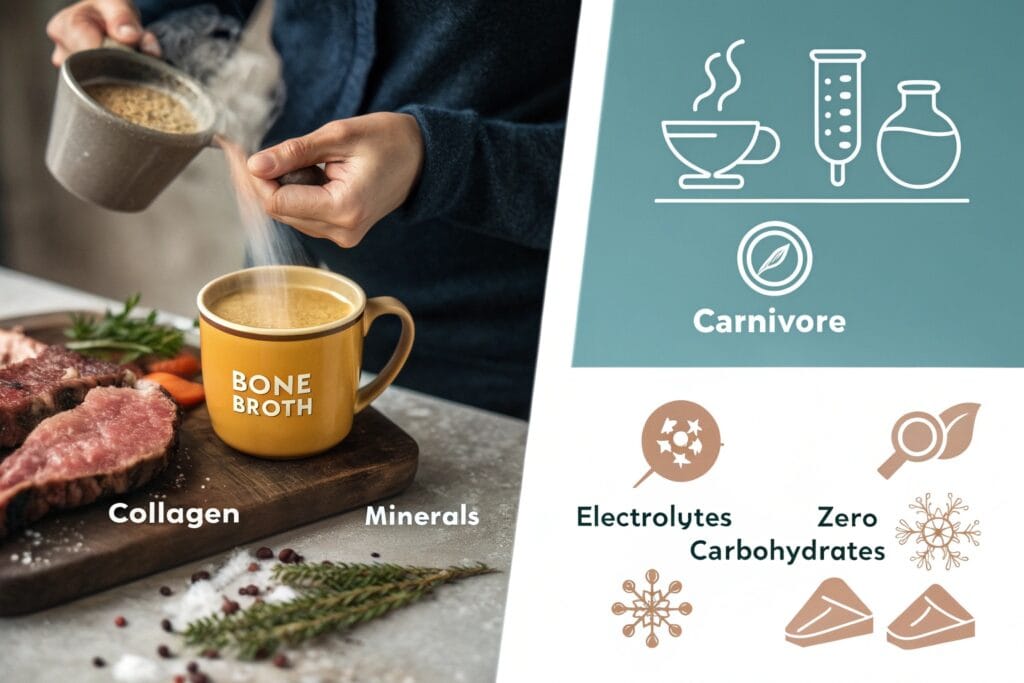Bone Broth Vs Regular Broth Vs Stock: What You Need To Know
In the world of culinary liquids, confusion reigns supreme. Walk down any grocery store aisle or flip through recipe books, and you’ll encounter terms like “bone broth,” “stock,” and “broth” used almost interchangeably. Yet for those following specialized eating approaches like the carnivore or keto diet, understanding these distinctions isn’t just culinary pedantry—it’s essential knowledge that impacts your nutrition and results.
Today, we’re clearing up the confusion once and for all. We’ll break down exactly what makes bone broth different from stock, how stock differs from regular broth, and which option delivers the most benefits for carnivore and keto enthusiasts.
Table of Contents

What is Bone Broth?
Bone broth has exploded in popularity over recent years, and for good reason. But what exactly makes it special compared to its culinary cousins?
At its core, bone broth is defined by its long-simmering process that extracts nutrients, minerals, and collagen from animal bones and connective tissues. The star ingredients here are bones—particularly joints, knuckles, feet, and other collagen-rich parts that many people typically discard.
Key Ingredients:
- Animal bones (with connective tissue still attached)
- Water
- Optional: Apple cider vinegar (helps extract minerals, though strictly speaking, this isn’t necessary for carnivore purists)
- Notably absent: Vegetables are minimized or completely omitted in true carnivore bone broth
Cooking Time:
Patience is essential for real bone broth. The extended cooking time (typically 12-48+ hours) is what sets it apart from other options. This long, slow simmer breaks down the collagen in connective tissues into gelatin and extracts minerals from the bones themselves.
Key Characteristics:
- Rich in Collagen/Gelatin: A properly made bone broth will gel when refrigerated—this is the hallmark of success and indicates a high collagen content.
- High in Minerals: The extended cooking process extracts calcium, magnesium, phosphorus, and other minerals from the bones.
- Flavor Profile: Deep, rich, and intensely savory from the marrow and bones, with a satisfying mouthfeel.
Primary Uses:
While bone broth shines as a base for soups and stews, what truly sets it apart is that it’s nutritious enough to be consumed on its own as a beverage. Many carnivore and keto dieters drink it straight from a mug, particularly during fasting periods or as a nutritional boost.
Learn how to make our perfect carnivore bone broth recipe here!

What is Stock?
Stock occupies the middle ground in our comparison—less labor-intensive than bone broth but more complex than regular broth.
Traditional stock is made by simmering bones (often roasted first for flavor) along with a mirepoix (a mixture of onions, carrots, and celery) and sometimes herbs or peppercorns. However, for carnivore and strict keto adherents, the vegetable components are typically reduced or eliminated.
Key Ingredients:
- Bones (often with less focus on connective tissue than bone broth)
- Water
- Traditional stocks include mirepoix (onions, celery, carrots), though keto/carnivore versions may omit these
- Sometimes herbs and spices
Cooking Time:
Stock requires a medium-length cooking process, typically 4-8 hours. This is long enough to extract some collagen and flavor, but considerably shorter than bone broth.
Key Characteristics:
- Moderate Gelatin Content: A good stock may gel lightly when refrigerated, but typically not as firmly as bone broth.
- Flavor Profile: Well-rounded, savory flavor that’s designed to complement other ingredients rather than stand alone.
Primary Uses:
Stock serves primarily as a foundation for other dishes—it’s the backbone of sauces, gravies, stews, and braises. It’s rarely consumed alone, unlike bone broth.

What is Broth (Regular/Meat Broth)?
Broth represents the quickest, simplest option of the three—and consequently, it’s often the least nutrient-dense for carnivore and keto dieters.
Key Ingredients:
- Primarily meat (with perhaps some incidental bones attached)
- Water
- Often includes mirepoix and herbs (though again, carnivore versions would omit these)
Cooking Time:
Broth requires the shortest cooking period, typically just 1-2 hours. This is enough to extract flavor from the meat but insufficient for breaking down collagen or extracting significant minerals from bones.
Key Characteristics:
- Minimal Gelatin: Regular broth rarely gels when refrigerated, indicating low collagen content.
- Flavor Profile: Lighter, cleaner flavor predominantly from the meat rather than bones.
Primary Uses:
Regular broth is commonly used for light soups, as a cooking liquid for grains or vegetables (less relevant for carnivore/keto eaters), or occasionally sipped on its own when someone is feeling under the weather. However, it lacks the nutritional punch of bone broth.
At-a-Glance: Bone Broth vs Stock vs Broth Comparison Table
| Feature | Bone Broth | Stock | Broth |
|---|---|---|---|
| Primary Ingredients | Bones with connective tissue | Bones (less connective tissue focus) | Primarily meat, few bones |
| Cooking Time | 12-48+ hours | 4-8 hours | 1-2 hours |
| Collagen/Gelatin Level | High (gels firmly) | Moderate (light gel) | Low (minimal gel) |
| Key Flavor Profile | Deep, rich, savory | Well-rounded, balanced | Light, clean, meat-forward |
| Primary Use | Sipping directly, recipe base | Base for sauces, stews | Light soups, cooking liquid |
| Keto/Carnivore Suitability | Excellent (highest nutrients) | Good (when made vegetable-free) | Fair (least nutrient-dense) |
Which is Best for Keto & Carnivore Diets?
When it comes to specialized dietary approaches like keto and carnivore, not all liquid bases are created equal. Let’s examine which option serves these nutritional philosophies best.
Bone Broth: The Gold Standard
For carnivore and keto dieters, properly made bone broth stands head and shoulders above the alternatives. Here’s why:
- Highest in Collagen/Gelatin: These proteins support gut health, joint function, and skin elasticity—all key benefits sought by many carnivore dieters.
- Rich in Electrolytes: The mineral content helps combat the “keto flu” and supports electrolyte balance during fat adaptation.
- Zero Carb Potential: When made without vegetables, bone broth is completely carbohydrate-free, making it ideal for strict carnivore protocols.
- Satiety Factor: The rich mouthfeel and protein content help manage hunger between meals.
For optimal results, make bone broth without high-carb vegetables or aromatics. Focus on quality bones from grass-fed animals when possible, as these will contain the most beneficial nutrients.
Learn about how bone broth supports electrolyte balance on keto
Stock: A Solid Alternative
Stock can be a good option for keto and carnivore dieters, though it generally offers fewer specific benefits than bone broth:
- Moderate Nutrient Content: Contains some collagen and minerals, though less than bone broth due to shorter cooking time.
- Versatility: Works well as a base for keto-friendly soups and sauces.
- Carnivore Adaptation: “Meat stock” (made without vegetables) provides a carnivore-friendly alternative that’s still nutritious.
For carnivore dieters, traditional stock recipes need modification to eliminate vegetables. A pure “meat stock” made only from bones and water is preferable.
Broth: The Least Ideal Option
Standard broth, while not harmful, offers the least nutritional value for those following carnivore or keto lifestyles:
- Low Collagen Content: The short cooking time and focus on meat rather than bones means minimal collagen extraction.
- Commercial Concerns: Store-bought broths often contain added sugars, maltodextrin, “natural flavors,” and other additives that can disrupt ketosis or contradict carnivore principles.
- Limited Benefits: While homemade meat broth is fine in a pinch, it simply doesn’t deliver the same nutritional density as bone broth.
If using store-bought broth, always check ingredients carefully. Many commercial options contain surprising amounts of carbohydrates, vegetable oils, or preservatives that may interfere with your dietary goals.
Discover how carnivore nutrition supports ketosis

Conclusion
Understanding the difference between bone broth, stock, and broth isn’t just culinary nitpicking—it’s essential knowledge for optimizing your nutrition on specialized dietary approaches like carnivore and keto.
When prioritizing nutrient density, collagen content, and compatibility with low-carb eating, bone broth emerges as the clear winner. Its extended cooking process extracts maximum nutrition from animal tissues, creating a versatile liquid that supports everything from gut health to joint function.
Stock offers a middle ground, providing decent nutrition with less cooking time, while standard broth, while quick to prepare, delivers the least nutritional punch of the three options.
Now that you understand the crucial differences, you can make informed choices about which to use in your carnivore or keto kitchen. Ready to start reaping the benefits? Try our Carnivore Bone Broth Recipe and experience the difference that proper preparation makes!
FAQ: Bone Broth vs Stock vs Broth
Can I use stock instead of bone broth?
While you can substitute stock for bone broth in recipes, you won’t get the same nutritional benefits. Stock contains less collagen, gelatin, and minerals than bone broth due to its shorter cooking time and often different ingredients. If you’re following carnivore or keto for therapeutic reasons, the distinction matters—bone broth provides significantly more gut-healing compounds and electrolytes. For general cooking purposes, however, stock works fine as a substitute.
Can I make bone broth from a regular broth recipe?
No, you cannot convert a standard broth recipe into bone broth simply by cooking it longer. True bone broth requires specific ingredients (bones with connective tissue) and an extended cooking time (12+ hours). Regular broth recipes focus on meat rather than bones and lack the collagen-rich components necessary for bone broth’s therapeutic properties. To make proper bone broth, you need to start with the right ingredients and commit to the long cooking process.
Is store-bought bone broth as good as homemade?
The quality of commercial bone broths varies dramatically. While some premium brands offer excellent products, many fall short in several key areas:
- Lower Collagen Content: Most commercial versions don’t gel well when refrigerated, indicating less collagen than properly made homemade versions.
- Questionable Ingredients: Many contain added sugars, vegetable oils, yeast extracts, or “natural flavors” that may not align with carnivore/keto principles.
- Dilution: Some commercial options are watered down to reduce costs.
For optimal results, make your own bone broth whenever possible. If purchasing commercially, look for brands that specifically mention long cooking times, use grass-fed bones, and have minimal ingredients.
Learn about other important carnivore diet supplements to consider
External Resources:
- National Institutes of Health: Collagen’s Role in Gut Health
- Journal of Nutrition: Meat Stock vs. Bone Broth Mineral Content Analysis
Enjoy, Review – We Value Your Opinion!
There are no reviews yet. Be the first one to write one.

